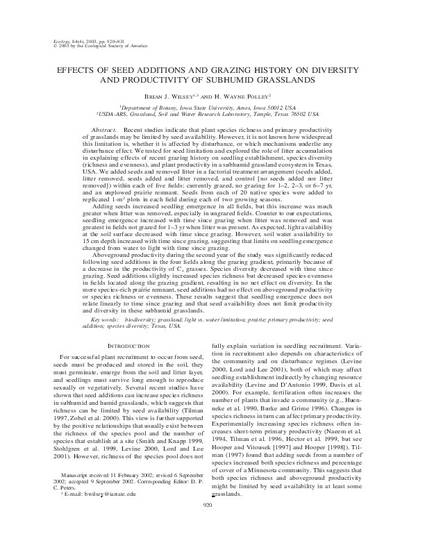
Article
Effects of Seed Additions and Grazing History on Diversity and Productivity of Subhumid Grasslands
Ecology
Document Type
Article
Disciplines
Publication Version
Published Version
Publication Date
4-1-2003
DOI
10.1890/0012-9658(2003)084[0920:EOSAAG]2.0.CO;2
Abstract
Recent studies indicate that plant species richness and primary productivity of grasslands may be limited by seed availability. However, it is not known how widespread this limitation is, whether it is affected by disturbance, or which mechanisms underlie any disturbance effect. We tested for seed limitation and explored the role of litter accumulation in explaining effects of recent grazing history on seedling establishment, species diversity (richness and evenness), and plant productivity in a subhumid grassland ecosystem in Texas, USA. We added seeds and removed litter in a factorial treatment arrangement (seeds added, litter removed, seeds added and litter removed, and control [no seeds added nor litter removed]) within each of five fields: currently grazed, no grazing for 1–2, 2–3, or 6–7 yr, and an unplowed prairie remnant. Seeds from each of 20 native species were added to replicated 1-m2 plots in each field during each of two growing seasons. Adding seeds increased seedling emergence in all fields, but this increase was much greater when litter was removed, especially in ungrazed fields. Counter to our expectations, seedling emergence increased with time since grazing when litter was removed and was greatest in fields not grazed for 1–3 yr when litter was present. As expected, light availability at the soil surface decreased with time since grazing. However, soil water availability to 15 cm depth increased with time since grazing, suggesting that limits on seedling emergence changed from water to light with time since grazing. Aboveground productivity during the second year of the study was significantly reduced following seed additions in the four fields along the grazing gradient, primarily because of a decrease in the productivity of C4 grasses. Species diversity decreased with time since grazing. Seed additions slightly increased species richness but decreased species evenness in fields located along the grazing gradient, resulting in no net effect on diversity. In the more species-rich prairie remnant, seed additions had no effect on aboveground productivity or species richness or evenness. These results suggest that seedling emergence does not relate linearly to time since grazing and that seed availability does not limit productivity and diversity in these subhumid grasslands.
Rights
Works produced by employees of the U.S. Government as part of their official duties are not copyrighted within the U.S. The content of this document is not copyrighted.
Language
en
File Format
application/pdf
Citation Information
Brian J. Wilsey and H. Wayne Polley. "Effects of Seed Additions and Grazing History on Diversity and Productivity of Subhumid Grasslands" Ecology Vol. 84 Iss. 4 (2003) p. 920 - 931 Available at: http://works.bepress.com/brian_wilsey/54/

This article is from Ecology 84 (2003): 920, doi:10.1890/0012-9658(2003)084[0920:EOSAAG]2.0.CO;2.